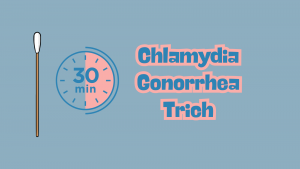
HPV-Related Head and Neck Cancer
You have probably heard that HPV can cause cervical cancer. But did you know that it can also cause cancers of the mouth, tongue, and throat?

Chlamydia is a common and curable infection caused by the bacteria chlamydia trachomatis. It is the most common reportable STI in the U.S. In 2022, there were about 1.6 million cases reported.
Chlamydia can cured with antibiotic treatment, but if left untreated it can lead to complications such as pelvic inflammatory disease (PID) and, potentially, infertility. It can also can also cause a potentially fatal ectopic pregnancy (a pregnancy that occurs outside the uterus).
Very. As stated, chlamydia is the most common reported bacterial sexually transmitted infection (STI) in the U.S. It is most common in younger people—it is estimated that 1 in 20 sexually active young women aged 14-24 years has chlamydia.
Chlamydia is passed through oral, anal, or vaginal sex. Chlamydia can be passed from one person to another even if the penis or tongue does not go all the way into the vagina or anus. Eye infections can occur when discharge caries the disease into the eye during sex or hand-to-eye contact.
Chlamydia can also be passed from mother to newborn as the baby passes through the infected birth canal. This can result in eye infections, pneumonia or other complications.
It is important to understand that focusing on signs and symptoms is not very useful in determining if someone is infected with chlamydia. First, the symptoms of chlamydia are similar to the symptoms of gonorrhea, and the two infections are often confused. Also most women and about half of men don’t have any symptoms. So, most people who are infected will not be able to tell from symptoms.
If a person does have symptoms, they usually develop within one to three weeks after exposure to chlamydia. How long a person remains infectious (able to transmit the bacteria to others) is difficult to determine since so many people are asymptomatic (have no symptoms). A person must be considered infectious from the time they become infected until treatment is completed.
If a person does have symptoms, they may include:
If the infection spreads to the fallopian tubes, symptoms may include:
Learn more about these two common—and curable—infections in this printable fact sheet. It covers the many things these two STIs have in common and includes information on testing, treatment, and staying healthy.
Because chlamydia is very common and so often has no symptoms, anyone who is sexually active should think about being tested. Because chlamydia is very common among young women, the Centers for Disease Control and Prevention (CDC) recommend sexually active women age 25 or younger get tested once per year. Chlamydia testing is also recommended for women with new or multiple sexual partners and pregnant women.
Anyone who is sexually active should talk with a healthcare provider about whether they need testing for chlamydia or other STIs. Don’t be afraid to speak openly about your sex life, as you can get the best care by having an honest discussion with your health care provider.
There are several different reliable tests for chlamydia. Newer tests, called NAATs (short for nucleic acid amplification tests), are very accurate and easy to take. Your health care provider can explain what testing options are available (urine or swab tests, for example). If you don’t have a regular healthcare provider, you can search here for a clinic near you.
People infected with chlamydia are often also infected with gonorrhea, so patients with chlamydia are often treated for gonorrhea at the same time, since the cost of treatment is generally less than the cost of testing.
If you live in Alaska, Maryland, or Washington, D.C., you can have a free at-home chlamydia test. Visit iwantthekit.org for more information.
There are antibiotic treatments that are effective in treating chlamydia. A health care provider will decide which antibiotic is prescribed, taking into consideration the particular needs of the patient.
Whatever treatment is prescribed, there are some important points about any treatment:
Chlamydia can be treated and cured easily, but that doesn’t mean that chlamydia infection isn’t potentially dangerous. If chlamydia isn’t diagnosed and left untreated, it can cause serious complications.
Untreated chlamydia infections in women may lead to:
Untreated chlamydia in men may lead to:

You have probably heard that HPV can cause cervical cancer. But did you know that it can also cause cancers of the mouth, tongue, and throat?

There’s new research to suggest that the birth control pill can protect female athletes from ACL tears which is one of the most common knee injuries. While this may sound far-fetched, the science behind it is very interesting.

The FDA just approved a new, fully at-home test for chlamydia, gonorrhea, and trichomoniasis. The tests, which is only for women, will be available without a prescription. Users can collect their own sample and have results in less than 30 minutes.

A new study of more than 200,000 women found that women who had ever taken the pill had a 26% lower risk of ovarian cancer.

Does your child feel it’s okay to talk with you about sex and sexual health? If not, have you thought about who will answer your child’s questions? Only you can tell your child that it’s okay to ask you questions. You want to become askable!

Many methods of birth control that are available today rely on hormones like those that our bodies make naturally. Hormonal methods come in many different forms—from pills to patches to shots—but all of them essentially work the same way.

Our reproductive health is an important part of our sexual health and our overall health. It includes our reproductive organs and our ability to get pregnant or get someone pregnant when we choose.

Anyone who is having penis-in-vagina sex runs the risk of getting pregnant every time they have sex. Even if it’s your first time. Even if you have your period. Even if it’s a full moon and Mercury is in retrograde.
ASHA believes that all people have the right to the information and services that will help them to have optimum sexual health. We envision a time when stigma is no longer associated with sexual health and our nation is united in its belief that sexuality is a normal, healthy, and positive aspect of human life.
ABOUT
GET INVOLVED
ASHA WEBSITES
GET HELP
© 2025 American Sexual Health Association